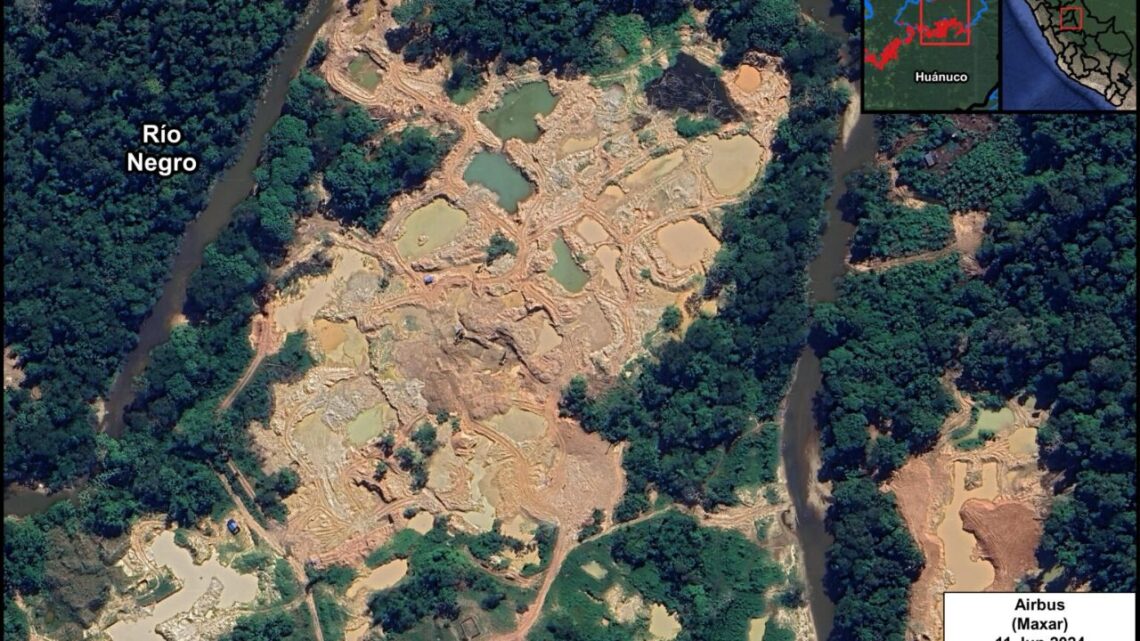Peru’s Amazon is now facing an intensification of mining activity that is fueling alarming levels of deforestation, river contamination, and threats to Indigenous territories.
Recent mapping and field investigations have revealed shifting trends: mining is migrating into new territories, adopting mobile tactics, and expanding both in depth and scope.
This article delves into what’s happening, why it’s significant, and what can be done about it.
The Changing Map of Mining-Driven Deforestation
Analyses covering over four decades (1984 to mid-2025) show that over 139,169 hectares of Amazon forest have been cleared due to gold mining operations.
While southern departments such as Madre de Dios have long been hotspots, new frontier zones are emerging in the northern and central Amazon, especially via riverine mining operations.
Regional Shifts: North, Central & South
- Northern Amazon (Loreto, Amazonas, Cajamarca): Mining here is increasingly river-based, using dredges and barges that can move rapidly up and down major waterways. In Loreto alone, nearly 989 dredge units were counted over recent years, signaling growing pressure on rivers like the Marañón, Nanay, and Napo.
- Central & Southern Amazon (Huánuco, Ucayali, Pasco, Madre de Dios): Mining remains land-based, involving heavy machinery to clear forest and dig pits. The area around La Pampa in Madre de Dios continues to be a battleground, despite past enforcement efforts.
- Frontier areas in Amazonas & Cajamarca: These zones, previously relatively untouched, are now seeing incursions from river dredging expanding upstream along tributaries such as the Chinchipe and portions of the Marañón.
Key Figures in Context
| Region / Department | Mining Modality | Approx. Deforestation / Impact | Important Rivers / Areas | Notes & Trends |
|---|---|---|---|---|
| Madre de Dios | Land-based machinery | Largest share of forest loss | La Pampa region, Tambopata | Post-raids rebound; extensive mining infrastructure in use |
| Huánuco / Pasco / Ucayali | Land-based, near reserves | Several thousand hectares around protected or Indigenous zones | Buffer zones to reserves | Encroachment near protected areas, increasing pressure |
| Loreto | River-based dredging | Nearly 1,000 dredge units in recent years | Marañón, Napo, Nanay rivers | High mobility operations; challenging enforcement |
| Amazonas / Cajamarca | River-based expansion | Losses climbing in “frontier” zones | Chinchipe, upstream Marañón | New pressure zones being established |
From this table, one sees that while southern land-based operations remain critical, the northern river operations represent a newer, more dynamic phase of threat.
Why the Shift to Rivers Is Dangerous
- Mobility & Evasion
Dredges and barges can relocate fast, making them harder to detect and intercept. Enforcement often lags behind. - Mercury & Water Contamination
River operations often use mercury in gold extraction, which contaminates downstream fisheries and threatens human health. - Forest Fragmentation
Even small clearings along riverbanks can degrade habitat, open access routes, and erode ecological connectivity. - Criminal Networks & Money Laundering
Organized groups increasingly control these operations, making mining not just an environmental problem but a governance and security issue.
Policy & Enforcement- Successes and Gaps
Short-term interventions—such as large raids and heavy-handed crackdowns—have sometimes put a dent in activities temporarily, but mining actors adapt, disperse, and resurface elsewhere. Without continuous pressure and coordination, the gains fade.
One of the biggest gaps is the absence of a full traceability system for gold. Without tracking a mineral’s path from ore to export—and monitoring its use of inputs like mercury, transport, and sales—it becomes nearly impossible to police or sanction bad actors consistently.
Also lacking is forest zoning integrated into mining permits, so mining is still being authorized too close to sensitive, high-value ecosystems.
Promisingly, regions under Indigenous stewardship often show lower deforestation rates, proving that empowering local communities can be part of an effective strategy.
Integrating advanced tools like drones, satellite monitoring, and river patrols can also help enforcement agencies stay ahead of mobile operators.
What Must Be Done to Turn the Tide
- Enforce traceability: Mandate full chain-of-custody accounting—inputs, transport, buyer, export—to deter laundering and illegal trade.
- Regulate inputs: Restrict and monitor the supply of mercury and fuel used by illegal miners.
- Strengthen patrols: Expand riverine enforcement presence, use remote sensing, drones, and rapid-response teams.
- Embed forest zoning: Ensure mining permits automatically exclude high-value forests and buffer zones around protected lands.
- Support Indigenous and community rights: Recognize and fund stewardship of forests, which has shown to reduce deforestation.
- Long-term governance commitment: One-off raids are insufficient—policy, institutional coordination, and sustained surveillance are essential.
Peru’s Amazon is confronting a new and escalating threat: the dual rise of river-based mining fronts and persistent land-based expansion.
With over 139,169 hectares already lost, and nearly 1,000 dredge units active in northern rivers, the urgency is clear.
Only a holistic approach—combining gold traceability, forest zoning, sustained enforcement, and Indigenous stewardship—can halt these new mining waves before they push the Amazon into deeper crisis.









